清华.经济学原理Chapter 23
- 格式:ppt
- 大小:1.43 MB
- 文档页数:47

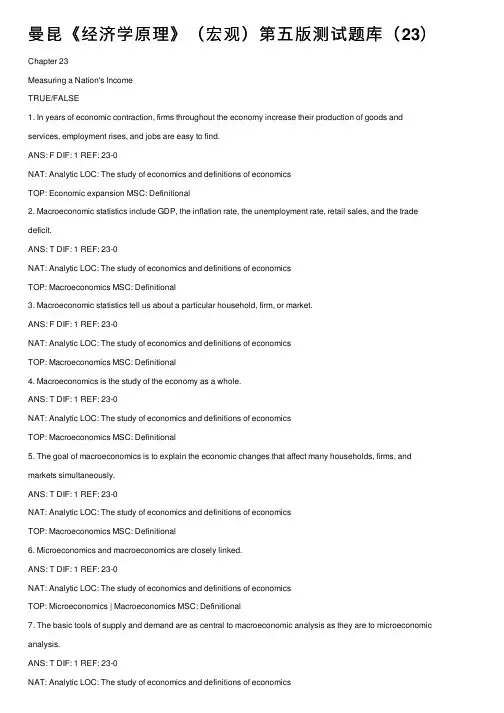
曼昆《经济学原理》(宏观)第五版测试题库(23)Chapter 23Measuring a Nation's IncomeTRUE/FALSE1. In years of economic contraction, firms throughout the economy increase their production of goods and services, employment rises, and jobs are easy to find.ANS: F DIF: 1 REF: 23-0NAT: Analytic LOC: The study of economics and definitions of economicsTOP: Economic expansion MSC: Definitional2. Macroeconomic statistics include GDP, the inflation rate, the unemployment rate, retail sales, and the trade deficit.ANS: T DIF: 1 REF: 23-0NAT: Analytic LOC: The study of economics and definitions of economicsTOP: Macroeconomics MSC: Definitional3. Macroeconomic statistics tell us about a particular household, firm, or market.ANS: F DIF: 1 REF: 23-0NAT: Analytic LOC: The study of economics and definitions of economicsTOP: Macroeconomics MSC: Definitional4. Macroeconomics is the study of the economy as a whole.ANS: T DIF: 1 REF: 23-0NAT: Analytic LOC: The study of economics and definitions of economicsTOP: Macroeconomics MSC: Definitional5. The goal of macroeconomics is to explain the economic changes that affect many households, firms, and markets simultaneously.ANS: T DIF: 1 REF: 23-0NAT: Analytic LOC: The study of economics and definitions of economicsTOP: Macroeconomics MSC: Definitional6. Microeconomics and macroeconomics are closely linked.ANS: T DIF: 1 REF: 23-0NAT: Analytic LOC: The study of economics and definitions of economicsTOP: Microeconomics | Macroeconomics MSC: Definitional7. The basic tools of supply and demand are as central to macroeconomic analysis as they are to microeconomic analysis.TOP: Demand | Supply MSC: Definitional8. GDP is the most closely watched economic statistic because it is thought to be the best single measure of asociety’s economic well-being.ANS: T DIF: 1 REF: 23-0NAT: Analytic LOC: The study of economics and definitions of economicsTOP: GDP MSC: Definitional9. GDP can measure either the total income of everyone in the economy or the total expenditure on theeconomy’s output of goods and services, but GDP cannot measure both at the same time.ANS: F DIF: 2 REF: 23-1NAT: Analytic LOC: The study of economics and definitions of economicsTOP: GDP MSC: Interpretive10. For an economy as a whole, income must exceed expenditure.ANS: F DIF: 1 REF: 23-1NAT: Analytic LOC: The study of economics and definitions of economics11. An economy’s income is the same as its expenditure because every transaction has a buyer and a seller. ANS: T DIF: 1 REF: 23-1NAT: Analytic LOC: The study of economics and definitions of economicsTOP: Income | Expenditure MSC: Definitional12. GDP is the market value of all final goods and services produced by a country’s citizens in a given period oftime.ANS: F DIF: 1 REF: 23-2NAT: Analytic LOC: The study of economics and definitions of economicsTOP: GDP MSC: Definitional13. GDP adds together many different kinds of products into a single measure of the value of economic activity byusing market prices.ANS: T DIF: 1 REF: 23-2NAT: Analytic LOC: The study of economics and definitions of economicsTOP: GDP MSC: Definitional14. U.S. GDP includes the market value of rental housing, but not the market value of owner-occupied housing. ANS: F DIF: 2 REF: 23-2NAT: Analytic LOC: The study of economics and definitions of economicsTOP: GDP MSC: Interpretive15. U.S. GDP excludes the production of most illegal goods.ANS: T DIF: 2 REF: 23-2NAT: Analytic LOC: The study of economics and definitions of economics16. U.S. GDP includes estimates of the value of items that are produced and consumed at home, such as housework and car maintenance.ANS: F DIF: 2 REF: 23-2NAT: Analytic LOC: The study of economics and definitions of economicsTOP: GDP MSC: Applicative17. GDP includes only the value of final goods because the value of intermediate goods is already included in the prices of the final goods.ANS: T DIF: 1 REF: 23-2NAT: Analytic LOC: The study of economics and definitions of economicsTOP: GDP | Intermediate goods MSC: Definitional18. Additions to inventory subtract from GDP, and when the goods in inventory are later used or sold, the reductions in inventory add to GDP.ANS: F DIF: 1 REF: 23-2NAT: Analytic LOC: The study of economics and definitions of economicsTOP: GDP | Inventory MSC: Definitional19. While GDP includes tangible goods such as books and bug spray, it excludes intangible services such as the services provided by teachers and exterminators.ANS: F DIF: 2 REF: 23-2NAT: Analytic LOC: The study of economics and definitions of economicsTOP: GDP MSC: Applicative20. At a rummage sale, you buy two old books and an old rocking chair; your spending on these items is not included in current GDP.ANS: T DIF: 2 REF: 23-2NAT: Analytic LOC: The study of economics and definitions of economicsTOP: GDP MSC: Applicative21. When an American doctor opens a practice in Bermuda, his production there is part of U.S. GDP.ANS: F DIF: 2 REF: 23-2NAT: Analytic LOC: The study of economics and definitions of economics1560 Chapter 23 /Measuring a Nation's Income22. If the U.S. government reports that GDP in the third quarter was $12 trillion at an annual rate, then the amount of income and expenditure during quarter three was $3 trillion.ANS: T DIF: 2 REF: 23-2NAT: Analytic LOC: The study of economics and definitions of economicsTOP: GDP MSC: Applicativedifferent stories about overall economic conditions.ANS: F DIF: 2 REF: 23-2NAT: Analytic LOC: The study of economics and definitions of economicsTOP: GDP | Income MSC: Interpretive24. Expenditures by households on education are included in the consumption component of GDP.ANS: T DIF: 2 REF: 23-3NAT: Analytic LOC: The study of economics and definitions of economicsTOP: Consumption MSC: Interpretive25. Most goods whose purchases are included in the investment component of GDP are used to produce other goods.ANS: T DIF: 2 REF: 23-3NAT: Analytic LOC: The study of economics and definitions of economicsTOP: Investment MSC: Interpretive26. New home construction is included in the consumption component of GDP.ANS: F DIF: 2 REF: 23-3NAT: Analytic LOC: The study of economics and definitions of economicsTOP: Investment MSC: Interpretive27. Changes in inventory are included in the investment component of GDP.ANS: T DIF: 2 REF: 23-3NAT: Analytic LOC: The study of economics and definitions of economicsTOP: Investment MSC: Interpretive28. The investment component of GDP refers to financial investment in stocks and bonds.ANS: F DIF: 2 REF: 23-3NAT: Analytic LOC: The study of economics and definitions of economicsTOP: Investment MSC: Interpretive29. The government purchases component of GDP includes salaries paid to soldiers but not Social Security benefits paid to the elderly.ANS: T DIF: 2 REF: 23-3NAT: Analytic LOC: The study of economics and definitions of economicsTOP: Government purchases MSC: Interpretive30. If the value of an economy’s imports exceeds the value of that economy’s exports, then net exports is a negative number.ANS: T DIF: 2 REF: 23-3NAT: Analytic LOC: The study of economics and definitions of economics31. If someone in the United States buys a surfboard produced in Australia, then that purchase is included in both the consumption component of U.S. GDP and the net exports component of U.S. GDP.ANS: T DIF: 2 REF: 23-3NAT: Analytic LOC: The study of economics and definitions of economicsTOP: Consumption | Net exports MSC: Applicative32. If consumption is $4000, exports are $300, government purchases are $1000, imports are $400, and investment is $800, then GDP is $5700.ANS: T DIF: 2 REF: 23-3NAT: Analytic LOC: The study of economics and definitions of economics33. If exports are $500, GDP is $8000, government purchases are $1200, imports are $700, and investment is $800, then consumption is $6200.ANS: T DIF: 2 REF: 23-3NAT: Analytic LOC: The study of economics and definitions of economicsTOP: Consumption MSC: Applicative34. If consumption is $1800, GDP is $4300, government purchases are $1000, imports are $700, and investment i s $1200, then exports are $300.ANS: F DIF: 2 REF: 23-3NAT: Analytic LOC: The study of economics and definitions of economicsTOP: Exports MSC: Applicative35. U.S. GDP was almost $14 billion in 2007.ANS: F DIF: 1 REF: 23-3NAT: Analytic LOC: The study of economics and definitions of economicsTOP: GDP MSC: Definitional36. In 2007, government purchases was the largest component of U.S. GDP.ANS: F DIF: 2 REF: 23-3NAT: Analytic LOC: The study of economics and definitions of economicsTOP: GDP MSC: Interpretive37. If total spending rises from one year to the next, then the economy must be producing a larger output of goods and services.ANS: F DIF: 2 REF: 23-4NAT: Analytic LOC: The study of economics and definitions of economicsTOP: GDP MSC: Interpretive38. An increase in nominal U.S. GDP necessarily implies that the United States is producing a larger output of goods and services.TOP: Nominal GDP MSC: Interpretive39. Nominal GDP uses constant base-year prices to place a value on the economy’s production of goods a nd services, while real GDP uses current prices to place a value on the economy’s production of goods and services.ANS: F DIF: 1 REF: 23-4NAT: Analytic LOC: The study of economics and definitions of economicsTOP: Nominal GDP | Real GDP MSC: Definitional40. Real GDP evaluates current production using prices that are fixed at past levels and therefore shows how the economy’s overall production of goods and services changes over time.ANS: T DIF: 1 REF: 23-4NAT: Analytic LOC: The study of economics and definitions of economicsTOP: Real GDP MSC: Definitional41. The term real GDP refers to a country’s actual GDP as opposed to its estimated GDP.ANS: F DIF: 2 REF: 23-4NAT: Analytic LOC: The study of economics and definitions of economicsTOP: Real GDP MSC: Interpretive42. Changes in real GDP reflect only changes in the amounts being produced.ANS: T DIF: 1 REF: 23-4NAT: Analytic LOC: The study of economics and definitions of economicsTOP: Real GDP MSC: Definitional43. Real GDP is a better gauge of economic well-being than is nominal GDP.ANS: T DIF: 1 REF: 23-4NAT: Analytic LOC: The study of economics and definitions of economics1562 Chapter 23 /Measuring a Nation's Income44. Changes in the GDP deflator reflect only changes in the prices of goods and services.ANS: T DIF: 2 REF: 23-4NAT: Analytic LOC: The study of economics and definitions of economicsTOP: GDP deflator MSC: Interpretive45. If nominal GDP is $10,000 and real GDP is $8,000, then the GDP deflator is 125.ANS: T DIF: 2 REF: 23-4NAT: Analytic LOC: The study of economics and definitions of economicsTOP: GDP deflator MSC: Applicative46. If nominal GDP is $12,000 and the GDP deflator is 80, then real GDP is $15,000.TOP: Real GDP MSC: Applicative47. Economists use the term inflation to describe a situation in whic h the economy’s overall production level isrising.ANS: F DIF: 1 REF: 23-4NAT: Analytic LOC: Unemployment and inflation TOP: InflationMSC: Definitional48. If the GDP deflator in 2006 was 160 and the GDP deflator in 2007 was 180, then the inflation rate in 2007 was12.5%.ANS: T DIF: 2 REF: 23-4NAT: Analytic LOC: Unemployment and inflation TOP: Inflation rateMSC: Applicative49. If the GDP deflator in 2004 was 150 and the GDP deflator in 2005 was 120, then the inflation rate in 2005 was25%.ANS: F DIF: 2 REF: 23-4NAT: Analytic LOC: Unemployment and inflation TOP: Inflation rateMSC: Applicative50. The GDP deflator can be used to take inflation out of nominal GDP.ANS: T DIF: 1 REF: 23-4NAT: Analytic LOC: The study of economics and definitions of economicsTOP: GDP deflator MSC: Definitional51. In 2004, the level of U.S. real GDP was close to four times its 1965 l evel.ANS: T DIF: 1 REF: 23-4NAT: Analytic LOC: The study of economics and definitions of economicsTOP: Real GDP MSC: Definitional52. The output of goods and services produced in the United States has grown on average 3.2 percent per year. ANS: T DIF: 1 REF: 23-4NAT: Analytic LOC: Productivity and growthTOP: GrowthMSC: Definitional53. Periods during which real GDP rises are called recessions.ANS: F DIF: 1 REF: 23-4NAT: Analytic LOC: The study of economics and definitions of economicsTOP: Recessions MSC: Definitional54. Recessions are associated with lower incomes, rising unemployment, and falling profits.TOP: Recessions MSC: Definitional55. If real GDP is higher in one country than in another, then we can be sure that the standard of living is higher inthe country with the higher real GDP.ANS: F DIF: 2 REF: 23-5NAT: Analytic LOC: The study of economics and definitions of economicsTOP: Real GDP | Standard of living MSC: Interpretive56. Real GDP per person tells us the income and expenditure of the average person in the economy.ANS: T DIF: 1 REF: 23-5NAT: Analytic LOC: The study of economics and definitions of economicsTOP: Real GDP per person MSC: Definitional57. GDP does not directly measure those things that make life worthwhile, but it does measure our ability toobtain many of the inputs into a worthwhile life.ANS: T DIF: 1 REF: 23-5NAT: Analytic LOC: The study of economics and definitions of economicsTOP: GDP MSC: Definitional58. GDP does not make adjustments for leisure time, environmental quality, or volunteer work.ANS: T DIF: 2 REF: 23-5NAT: Analytic LOC: The study of economics and definitions of economicsTOP: GDP MSC: Interpretive59. Other things equal, in countries with higher levels of real GDP per person, life expectancy and literacy ratesare higher than in countries with lower levels of real GDP per person.ANS: T DIF: 2 REF: 23-5NAT: Analytic LOC: The study of economics and definitions of economicsTOP: GDP MSC: InterpretiveSHORT ANSWER1. GDP is defined as the market value of all final goods and services produced within a country in a given periodof time. In spite of this definition, some production is left out of GDP. Explain why some final goods and services are not included.ANS:GDP excludes some products because they are so difficult to measure. These products include services performed by individuals for themselves and their families, and most goods that are produced and consumed at home and, therefore, never enter the marketplace. In addition, illegal products are not included in GDP even if they can be measured because, by society's definition, they are bads, not goods.DIF: 2 REF: 23-2 NAT: AnalyticLOC: The study of economics and definitions of economics TOP: GDPMSC: Interpretiveincluded directly as part of GDP, but the value of intermediate goods produced and not sold is includeddirectly as part of GDP.ANS:Intermediate goods produced and sold during the year are not included separately as part of GDP because the value of those goods is included in the value of the final goods produced from them. If the intermediate good is produced but not sold during the year, its value is included as inventory investment for the year in which it was produced. If inventory investment was not included as part of GDP, true production would be underestimated for the year the intermediate good went into inventory, and overestimated for the year the intermediate good is used or sold.DIF: 2 REF: 23-2 NAT: AnalyticLOC: The study of economics and definitions of economics TOP: GDP | Intermediate goods MSC: Interpretive1564 Chapter 23 /Measuring a Nation's Income3. Since it is counted as investment, why doesn't the purchase of earthmoving equipment from China by a U.S.corporation increase U.S. GDP?ANS:The purchase of foreign equipment is counted as investment, but GDP measures only the value of production within the geographic borders of the United States. In order to avoid including the value of the imported equipment, imports are subtracted from GDP. Hence, the value of the equipment in investment is canceled by subtracting its value as an import.DIF: 2 REF: 23-3 NAT: AnalyticLOC: The study of economics and definitions of economics TOP: GDP | Investment | Imports MSC: Applicative4. Identify the immediate effect of each of the following events on U.S. GDP and its components.a. James receives a Social Security check.b. John buys an Italian sports car.c. Henry buys domestically produced tools for his construction company.ANS:a. Since this is a transfer payment, there is no change to GDP or to any of its components.b. Consumption and imports will rise and cancel each other out so that there is no change in U.S. G DP.c. This increases the investment component of GDP and so increases GDP.DIF: 2 REF: 23-3 NAT: AnalyticLOC: The study of economics and definitions of economicsTOP: GDP | Transfer payments | Net exports | Investment MSC: Applicative5. Between 1929 and 1933, NNP measured in current prices fell from $96 billion to $48 billion. Over the sameperiod, the relevant price index fell from 100 to 75.a. What was the percentage decline in nominal NNP from 1929 to1933?b. What was the percentage decline in real NNP from 1929 to 1933? Show your work.ANS:a. NNP measured in current prices is nominal NNP. Nominal NNP fell from $96 billion to $48 billion, adecline of 50 percent.($96 b/100) 100 = $96 b. Real NNP in 1933 was ($48 b/75) 100 = $64 b. Real NNP fell from$96 billion to $64 billion, a decline of 33 percent.DIF: 2 REF: 23-4 NAT: AnalyticLOC: The study of economics and definitions of economics TOP: Nominal NNP | Real NNP MSC: Applicative6. You find that your paycheck for the year is higher this year than last. Does that mean that your real incomehas increased? Explain carefully.ANS:Real income is nominal income adjusted for general increase in prices. I f my paycheck is higher this year than last, my nominal income has increased. Whether my real income has increased or not depends on what has happened since last year to the level of prices of things I buy with my income. If the percentage increase in prices is less than the percentage increase in my nominal income, then my real income h as increased. Otherwise, my real income has not increased.DIF: 2 REF: 23-4 NAT: AnalyticLOC: The study of economics and definitions of economicsTOP: Nominal income | Real income MSC: Interpretive7. U.S. real GDP is substantially higher today than it was 60 years ago. What does this tell us, and what does itnot tell us, about the well-being of U.S. residents?ANS:Since this is in real terms, it tells us that the U.S. is able to make a lot more stuff than in the past. Some of the increase in real GDP is probably due to an increase in population, so we could say more if we knew what had happened to real GDP per person. Supposing that there was also an increase in real GDP per person, we can say that the standard of living has risen. Material things are an important part of well-being. Having sufficient amounts of things such as food, shelter, and clothing are fundamental to well-being. Other things such as security, a safe environment, access to safe water, access to medical care, justice, and freedom also matter. However, many of these things are more easily obtained by being able to produce more using fewer resources. Countries with higher real GDP per person tend to have longer life spans, less discrimination towards women, less child labor, and a higher rate of literacy.DIF: 2 REF: 23-5 NAT: AnalyticLOC: The study of economics and definitions of economicsTOP: Real GDP | Economic welfare MSC: InterpretiveSec00 - Measuring a Nation's IncomeMULTIPLE CHOICE1. Statistics that are of particular interest to macroeconomistsa. are largely ignored by the media.b. are widely reported by the media.c. include the equilibrium prices of individual goods and services.d. tell us about a particular household, firm, or market.ANS: B DIF: 2 REF: 23-0NAT: Analytic LOC: The study of economics and definitions of economicsTOP: Macroeconomics MSC: Interpretiveb. the interaction between households and firms.c. economy-wide phenomena.d. regulations on firms and unions.ANS: C DIF: 1 REF: 23-0NAT: Analytic LOC: The study of economics and definitions of economicsTOP: Macroeconomics MSC: Definitional3. Which of the following newspaper headlines is more closely related to what microeconomists study than to what macroeconomists study?a. Unemployment rate rises from 5 percent to 5.5 percent.b. Real GDP grows by 3.1 percent in the third quarter.c. Retail sales at stores show large gains.d. The price of oranges rises after an early frost.ANS: D DIF: 2 REF: 23-0NAT: Analytic LOC: The study of economics and definitions of economicsTOP: Microeconomics | Macroeconomics MSC: Interpretive4. Which of the following questions is more likely to be studied by a microeconomist than a macroeconomist?a. Why do prices in general rise by more in some countries than in others?b. Why do wages differ across industries?c. Why do production and income increase in some periods and not in others?d. How rapidly is GDP currently increasing?ANS: B DIF: 2 REF: 23-0NAT: Analytic LOC: The study of economics and definitions of economicsTOP: Microeconomics | Macroeconomics MSC: Interpretive1566 Chapter 23 /Measuring a Nation's Income5. Which of the following topics are more likely to be studied by a macroeconomist than by a microeconomist?a. the effect of taxes on the prices of airline tickets, the profitability of automobile-manufacturingfirms, and employment trends in the food-service industryb. the price of beef, wage differences between genders, and antitrust lawsc. how consumers maximize utility, and how prices are established in markets for agriculturalproductsd. the percentage of the labor force that is out of work, and differences in average income fromcountry to countryANS: D DIF: 2 REF: 23-0NAT: Analytic LOC: The study of economics and definitions of economicsTOP: Microeconomics | Macroeconomics MSC: Interpretive6. We would expect a macroeconomist, as opposed to a microeconomist, to be particularly interested ina. explaining how economic changes affect prices of particular goods.b. devising policies to deal with market failures such as externalities and market power.c. devising policies to promote low inflation.d. identifying those markets that are competitive and those that are not competitive.ANS: C DIF: 2 REF: 23-0NAT: Analytic LOC: The study of economics and definitions of economicsTOP: Microeconomics | Macroeconomics MSC: Interpretive7. Which of the following is not a question that macroeconomists address?a. Why is average income high in some countries while it is low in others?b. Why does the price of oil rise when war erupts in the Middle East?c. Why do production and employment expand in some years and contract in others?d. Why do prices rise rapidly in some periods of time while they are more stable in other periods? ANS: B DIF: 2 REF: 23-0 NAT: Analytic LOC: The study of economics and definitions of economicsTOP: Macroeconomics MSC: Interpretive8. The basic tools of supply and demand area. useful only in the analysis of economic behavior in individual markets.b. useful in analyzing the overall economy, but not in analyzing individual markets.c. central to microeconomic analysis, but seldom used in macroeconomic analysis.d. central to macroeconomic analysis as well as to microeconomic analysis.ANS: D DIF: 1 REF: 23-0NAT: Analytic LOC: The study of economics and definitions of economicsTOP: Demand | Supply MSC: Definitional9. Which of the following statistic is usually regarded as the best single measure of a society’s economic well-being?a. the unemployment rateb. the inflation ratec. gross domestic productd. the trade deficitANS: C DIF: 1 REF: 23-0NAT: Analytic LOC: The study of economics and definitions of economicsTOP: GDP MSC: DefinitionalSec01 - Measuring a Nation's Income - The Economy's Income and Expenditure MULTIPLE CHOICE1. Which of the following statements about GDP is correct?a. GDP measures two things at once: the total income of everyone in the economy and the unemployment rate of the economy’s labor force.b. Money continuously flows from households to government and then back to households, and GDP measures this flow of money.c. GDP is to a nation’s economy as household income is to a household.d. All of the above are correct.ANS: C DIF: 2 REF: 23-1NAT: Analytic LOC: The study of economics and definitions of economicsTOP: GDP MSC: Interpretive2. Gross domestic product measures two things at once:a. the total spending of everyone in the economy and the total saving of everyone in the economy.b. the total income of everyone in the economy and the total expenditure on the economy's output of goods and services.c. the value of the economy's output of goods and services for domestic citizens and the value of the economy's output of goods and services for the rest of the world.d. the total income of households in the economy and the total profit of firms in the economy. ANS: B DIF: 1 REF: 23-1NAT: Analytic LOC: The study of economics and definitions of economicsTOP: GDP MSC: Definitional3. For an economy as a whole,a. wages must equal profit.b. consumption must equal saving.c. income must equal expenditure.d. the number of buyers must equal the number of sellers.ANS: C DIF: 2 REF: 23-1NAT: Analytic LOC: The study of economics and definitions of economicsTOP: Income | Expenditure MSC: Interpretive4. For an economy as a whole, income must equal expenditure becausea. the number of firms is equal to the number of households in an economy.b. international law requires that income equal expenditure.c. every dollar of spending by some buyer is a dollar of income for some seller.d. every dollar of saving by some consumer is a dollar of spending by some other consumer. ANS: C DIF: 2 REF: 23-1NAT: Analytic LOC: The study of economics and definitions of economicsTOP: Income | Expenditure MSC: Interpretive5. If an economy’s GDP rises, then it must be the case that the economy’sa. income rises and saving falls.b. income and saving both rise.c. income rises and expenditure falls.d. income and expenditure both rise.ANS: D DIF: 2 REF: 23-1NAT: Analytic LOC: The study of economics and definitions of economics TOP: Income | Expenditure MSC: Interpretive。
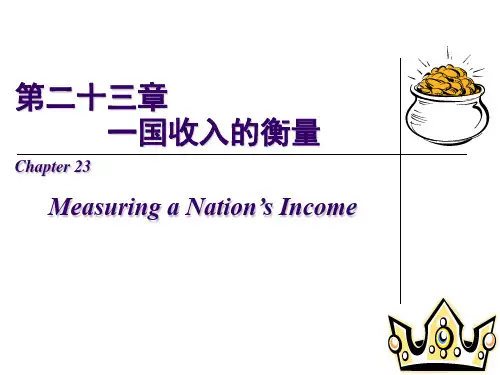
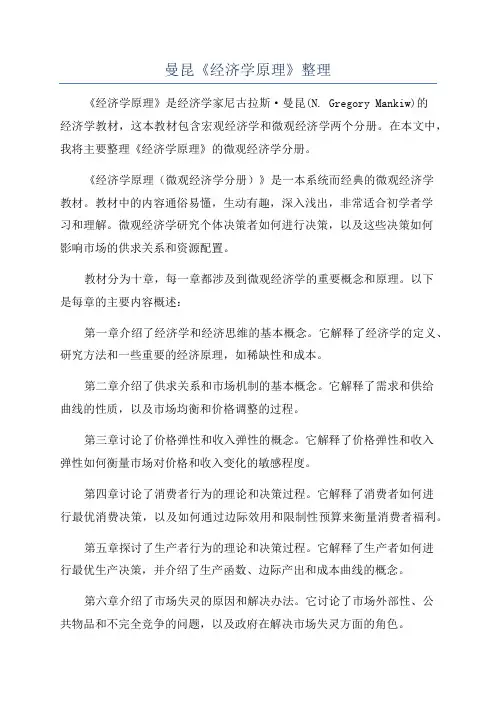
曼昆《经济学原理》整理《经济学原理》是经济学家尼古拉斯·曼昆(N. Gregory Mankiw)的经济学教材,这本教材包含宏观经济学和微观经济学两个分册。
在本文中,我将主要整理《经济学原理》的微观经济学分册。
《经济学原理(微观经济学分册)》是一本系统而经典的微观经济学教材。
教材中的内容通俗易懂,生动有趣,深入浅出,非常适合初学者学习和理解。
微观经济学研究个体决策者如何进行决策,以及这些决策如何影响市场的供求关系和资源配置。
教材分为十章,每一章都涉及到微观经济学的重要概念和原理。
以下是每章的主要内容概述:第一章介绍了经济学和经济思维的基本概念。
它解释了经济学的定义、研究方法和一些重要的经济原理,如稀缺性和成本。
第二章介绍了供求关系和市场机制的基本概念。
它解释了需求和供给曲线的性质,以及市场均衡和价格调整的过程。
第三章讨论了价格弹性和收入弹性的概念。
它解释了价格弹性和收入弹性如何衡量市场对价格和收入变化的敏感程度。
第四章讨论了消费者行为的理论和决策过程。
它解释了消费者如何进行最优消费决策,以及如何通过边际效用和限制性预算来衡量消费者福利。
第五章探讨了生产者行为的理论和决策过程。
它解释了生产者如何进行最优生产决策,并介绍了生产函数、边际产出和成本曲线的概念。
第六章介绍了市场失灵的原因和解决办法。
它讨论了市场外部性、公共物品和不完全竞争的问题,以及政府在解决市场失灵方面的角色。
第七章讨论了消费者剩余和生产者剩余的概念。
它解释了消费者剩余和生产者剩余如何衡量买家和卖家对交易的满意程度。
第八章讨论了纳什均衡和博弈理论的概念。
它解释了博弈理论如何帮助我们理解决策者之间的相互作用和策略选择。
第九章介绍了垄断和垄断竞争的市场结构。
它解释了垄断者如何通过价格和产量限制来影响市场,并讨论了垄断竞争下的市场行为。
第十章介绍了资源市场的概念和原理。
它解释了劳动市场和资本市场如何确定工资和利率,并讨论了市场竞争对工资和利率的影响。


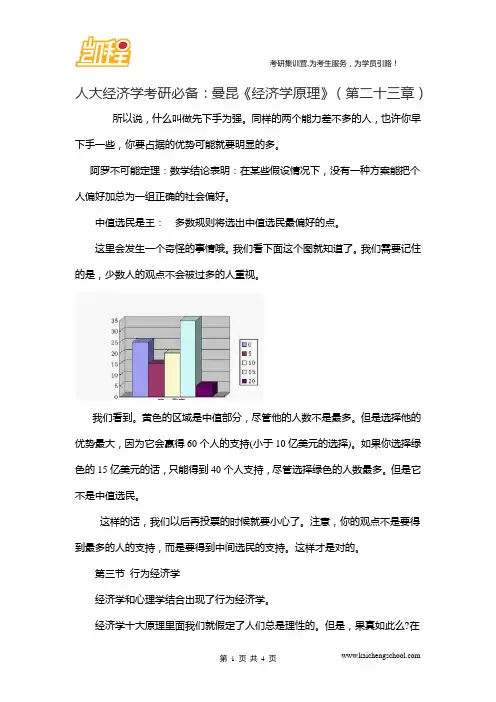
人大经济学考研必备:曼昆《经济学原理》(第二十三章)所以说,什么叫做先下手为强。
同样的两个能力差不多的人,也许你早下手一些,你要占据的优势可能就要明显的多。
阿罗不可能定理:数学结论表明:在某些假设情况下,没有一种方案能把个人偏好加总为一组正确的社会偏好。
中值选民是王:多数规则将选出中值选民最偏好的点。
这里会发生一个奇怪的事情哦。
我们看下面这个图就知道了。
我们需要记住的是,少数人的观点不会被过多的人重视。
我们看到。
黄色的区域是中值部分,尽管他的人数不是最多。
但是选择他的优势最大,因为它会赢得60个人的支持(小于10亿美元的选择)。
如果你选择绿色的15亿美元的话,只能得到40个人支持,尽管选择绿色的人数最多。
但是它不是中值选民。
这样的话,我们以后再投票的时候就要小心了。
注意,你的观点不是要得到最多的人的支持,而是要得到中间选民的支持。
这样才是对的。
第三节行为经济学经济学和心理学结合出现了行为经济学。
经济学十大原理里面我们就假定了人们总是理性的。
但是,果真如此么?在博弈论的研究当中,我们就说过,人们总是习惯去惩罚不遵守规定的人......因为人们关心社会的公正。
你能保证你10岁以前你一直认为是对的观点现在还有效么——我基本上可以保证这个世界不需要这么多的总统,国家主席之类的官——哈哈,现在你可能不这么想了吧,因为你的观点在变化。
有这样的一些观点:1)人们并不总是理性的a.人们总是过于自信。
b.人们过分注意观察到的小数。
你已经知道了一个1000的样本通过了测试,但是你突然发现有第1001个样本没有通过测试,实际上的通过率已经很高了。
但是人们过于关注小的数字,而忘记了大局的观念。
c.人们拒绝改变自己的思想。
还记得华氏911这部电影么,他的结果使得支持戈尔的更加支持戈尔,支持布什的更加支持布什,其余并没有改变什么。
2)人们关心公正恩。
博弈理论那一章我们有提到一个观点就是这样的,人们会去惩罚不遵守规定的人。
3)人并不总是一致的第二十三章一国收入的衡量相信大家或多或少的关注过GDP(gross domestic product)。
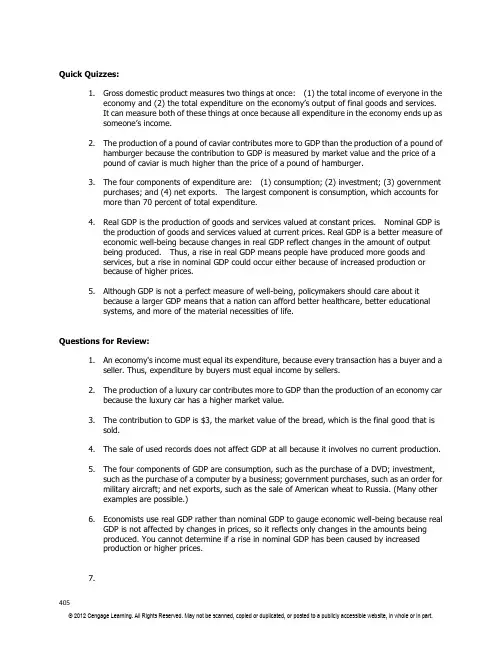
Quick Quizzes:1. Gross domestic product measures two things at once: (1) the total income of everyone in theeconomy and (2) the total expenditure on the economy’s output of final goods and services.It can measure both of these things at once because all expenditure in the economy ends up assomeone’s income.2. The production of a pound of caviar contributes more to GDP than the production of a pound ofhamburger because the contribution to GDP is measured by market value and the price of apound of caviar is much higher than the price of a pound of hamburger.3. The four components of expenditure are: (1) consumption; (2) investment; (3) governmentpurchases; and (4) net exports. The largest component is consumption, which accounts formore than 70 percent of total expenditure.4. Real GDP is the production of goods and services valued at constant prices. Nominal GDP isthe production of goods and services valued at current prices. Real GDP is a better measure ofeconomic well-being because changes in real GDP reflect changes in the amount of outputbeing produced. Thus, a rise in real GDP means people have produced more goods andservices, but a rise in nominal GDP could occur either because of increased production orbecause of higher prices.5. Although GDP is not a perfect measure of well-being, policymakers should care about itbecause a larger GDP means that a nation can afford better healthcare, better educationalsystems, and more of the material necessities of life.Questions for Review:1. An economy's income must equal its expenditure, because every transaction has a buyer and aseller. Thus, expenditure by buyers must equal income by sellers.2. The production of a luxury car contributes more to GDP than the production of an economy carbecause the luxury car has a higher market value.3. The contribution to GDP is $3, the market value of the bread, which is the final good that issold.4. The sale of used records does not affect GDP at all because it involves no current production.5. The four components of GDP are consumption, such as the purchase of a DVD; investment,such as the purchase of a computer by a business; government purchases, such as an order formilitary aircraft; and net exports, such as the sale of American wheat to Russia. (Many otherexamples are possible.)6. Economists use real GDP rather than nominal GDP to gauge economic well-being because realGDP is not affected by changes in prices, so it reflects only changes in the amounts beingproduced. You cannot determine if a rise in nominal GDP has been caused by increasedproduction or higher prices.7.405The percentage change in nominal GDP is (600 – 200)/200 x 100% = 200%. The percentagechange in real GDP is (400 – 200)/200 x 100% = 100%. The percentage change in the deflator is (150 – 100)/100 x 100% = 50%.8. It is desirable for a country to have a large GDP because people could enjoy more goods andservices. But GDP is not the only important measure of well-being. For example, laws thatrestrict pollution cause GDP to be lower. If laws against pollution were eliminated, GDP wouldbe higher but the pollution might make us worse off. Or, for example, an earthquake wouldraise GDP, as expenditures on cleanup, repair, and rebuilding increase. But an earthquake is anundesirable event that lowers our welfare.Problems and Applications1. a. Consumption increases because a refrigerator is a good purchased by a household.b. Investment increases because a house is an investment good.c. Consumption increases because a car is a good purchased by a household, but investmentdecreases because the car in For d’s inventory had been counted as an investment gooduntil it was sold.d. Consumption increases because pizza is a good purchased by a household.e. Government purchases increase because the government spent money to provide a goodto the public.f. Consumption increases because the bottle is a good purchased by a household, but netexports decrease because the bottle was imported.g. Investment increases because new structures and equipment were built.2. With transfer payments, nothing is produced, so there is no contribution to GDP.3. If GDP included goods that are resold, it would be counting output of that particular year, plussales of goods produced in a previous year. It would double-count goods that were sold morethan once and would count goods in GDP for several years if they were produced in one yearand resold in another.4. a. Calculating nominal GDP:2010: ($1 per qt. of milk ⨯ 100 qts. milk) + ($2 per qt. of honey ⨯ 50 qts. honey) = $2002011: ($1 per qt. of milk ⨯ 200 qts. milk) + ($2 per qt. of honey ⨯ 100 qts. honey) = $4002012: ($2 per qt. of milk ⨯ 200 qts. milk) + ($4 per qt. of honey ⨯ 100 qts. honey) = $800Calculating real GDP (base year 2010):2010: ($1 per qt. of milk ⨯ 100 qts. milk) + ($2 per qt. of honey ⨯ 50 qts. honey) = $2002011: ($1 per qt. of milk ⨯ 200 qts. milk) + ($2 per qt. of honey ⨯ 100 qts. honey) = $4002012: ($1 per qt. of milk ⨯ 200 qts. milk) + ($2 per qt. of honey ⨯ 100 qts. honey) = $400Calculating the GDP deflator:2010: ($200/$200) ⨯ 100 = 1002011: ($400/$400) ⨯ 100 = 1002012: ($800/$400) ⨯ 100 = 200b. Calculating the percentage change in nominal GDP:Percentage change in nominal GDP in 2011 = [($400 – $200)/$200] ⨯ 100% = 100%.Percentage change in nominal GDP in 2012 = [($800 – $400)/$400] ⨯ 100% = 100%. Calculating the percentage change in real GDP:Percentage change in real GDP in 2011 = [($400 – $200)/$200] ⨯ 100% = 100%.Percentage change in real GDP in 2012 = [($400 – $400)/$400] ⨯ 100% = 0%. Calculating the percentage change in GDP deflator:Percentage change in the GDP deflator in 2011 = [(100 – 100)/100] ⨯ 100% = 0%.Percentage change in the GDP deflator in 2012 = [(200 – 100)/100] ⨯ 100% = 100%.Prices did not change from 2010 to 2011. Thus, the percentage change in the GDP deflator is zero. Likewise, output levels did not change from 2011 to 2012. This means that thepercentage change in real GDP is zero.c. Economic well-being rose more in 2010 than in 2011, since real GDP rose in 2011 but not in2012. In 2011, real GDP rose but prices did not. In 2012, real GDP did not rise but prices did.5. a. C alculating Nominal GDP:Year 1: (3 bars ⨯ $4) = $12Year 2: (4 bars ⨯ $5) = $20Year 3: (5 bars ⨯ $6) = $30b. C alculating Real GDP:Year 1: (3 bars ⨯ $4) = $12Year 2: (4 bars ⨯ $4) = $16Year 3: (5 bars ⨯ $4) = $20c. Calculating the GDP delator:Year 1: $12/$12 ⨯ 100 = 100Year 2: $20/$16 ⨯ 100 = 125Year 3: $30/$20 ⨯ 100 = 150d. T he growth rate from Year 2 to Year 3 = (16 – 12)/12 ⨯ 100% = 4/12 ⨯ 100% = 33.3%e. The inflation rate from Year 2 to Year 3 = (150 – 125)/125 ⨯ 100% = 25/125 ⨯ 100% =20%.f. To calculate the growth rate of real GDP, we could simply calculate the percentage changein the quantity of bars. To calculate the inflation rate, we could measure the percentage change in the price of bars.6.a. The growth rate of nominal GDP = 100% ⨯ [($14,256/$9,353)0.10– 1] = 4.3%b. The growth rate of the deflator = 100% ⨯ [(109.886.8)0.10– 1] = 2.4%c. Real GDP in 1999 (in 2005 dollars) is $9,353/(86.8/100) = $10,775.35.d. Real GDP in 2009 (in 2005 dollars) is $14,256/(109.8/100) = $12,983.61.e. The growth rate of real GDP = 100% ⨯ [($12,983.61/$10,775.35)0.10– 1] = 1.9%f. The growth rate of nominal GDP is higher than the growth rate of real GDP because ofinflation.7. Many answers are possible.8. a. GDP is the market value of the final good sold, $180.b. Value added for the farmer: $100.Value added for the miller: $150 – $100 = $50.Value added for the baker: $180 – $150 = $30.c. Together, the value added for the three producers is $100 + $50 + $30 = $180. This is thevalue of GDP.9. In countries like India, people produce and consume a fair amount of food at home that is notincluded in GDP. So GDP per person in India and the United States will differ by more than their comparative economic well-being.10. a. The increased labor-force participation of women has increased GDP in the United States,because it means more people are working and production has increased.b. If our measure of well-being included time spent working in the home and taking leisure, itwould not rise as much as GDP, because the rise in women's labor-force participation has reduced time spent working in the home and taking leisure.c. Other aspects of well-being that are associated with the rise in women's increasedlabor-force participation include increased self-esteem and prestige for women in theworkforce, especially at managerial levels, but decreased quality time spent with children, whose parents have less time to spend with them. Such aspects would be quite difficult to measure.11. a. GDP equals the dollar amount Barry collects, which is $400.b. NNP = GDP – depreciation = $400 – $50 = $350.c. National income = NNP = $350.d. Personal income = national income – retained earnings – indirect business taxes = $350 –$100 – $30 = $220.e. Disposable personal income = personal income – personal income tax = $220 – $70 =$150.。


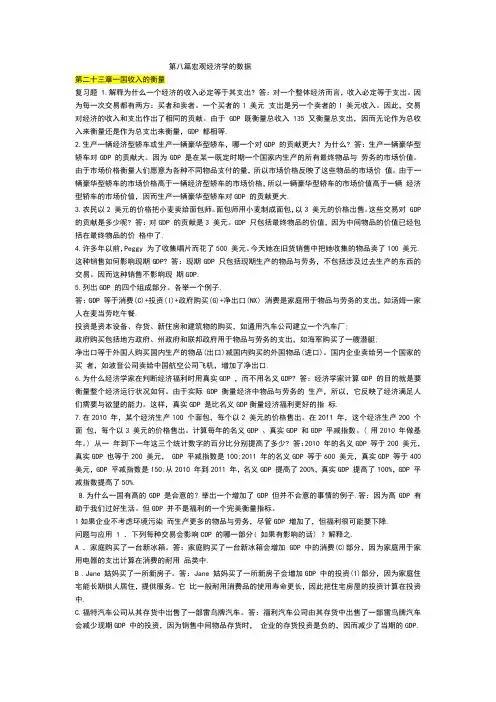
第八篇宏观经济学的数据第二十三章一国收入的衡量复习题 1.解释为什么一个经济的收入必定等于其支出? 答:对一个整体经济而言,收入必定等于支出。
因为每一次交易都有两方:买者和卖者。
一个买者的1 美元支出是另一个卖者的1 美元收入。
因此,交易对经济的收入和支出作出了相同的贡献。
由于GDP 既衡量总收入 135 又衡量总支出,因而无论作为总收入来衡量还是作为总支出来衡量,GDP 都相等.2.生产一辆经济型轿车或生产一辆豪华型轿车,哪一个对GDP 的贡献更大?为什么? 答:生产一辆豪华型轿车对GDP 的贡献大。
因为GDP 是在某一既定时期一个国家内生产的所有最终物品与劳务的市场价值。
由于市场价格衡量人们愿意为各种不同物品支付的量,所以市场价格反映了这些物品的市场价值。
由于一辆豪华型轿车的市场价格高于一辆经济型轿车的市场价格,所以一辆豪华型轿车的市场价值高于一辆经济型轿车的市场价值,因而生产一辆豪华型轿车对GDP 的贡献更大.3.农民以2 美元的价格把小麦卖给面包师。
面包师用小麦制成面包,以3 美元的价格出售。
这些交易对 GDP 的贡献是多少呢? 答:对GDP 的贡献是3 美元。
GDP 只包括最终物品的价值,因为中间物品的价值已经包括在最终物品的价格中了.4.许多年以前,Peggy 为了收集唱片而花了500 美元。
今天她在旧货销售中把她收集的物品卖了100 美元. 这种销售如何影响现期GDP? 答:现期GDP 只包括现期生产的物品与劳务,不包括涉及过去生产的东西的交易。
因而这种销售不影响现期GDP.5.列出GDP 的四个组成部分。
各举一个例子.答:GDP 等于消费(C)+投资(I)+政府购买(G)+净出口(NX) 消费是家庭用于物品与劳务的支出,如汤姆一家人在麦当劳吃午餐.投资是资本设备、存货、新住房和建筑物的购买,如通用汽车公司建立一个汽车厂;政府购买包括地方政府、州政府和联邦政府用于物品与劳务的支出,如海军购买了一艘潜艇;净出口等于外国人购买国内生产的物品(出口)减国内购买的外国物品(进口)。
经济学原理电子书引言经济学是研究人类如何分配资源的学科。
它探讨了人们如何做出决策,以及这些决策如何影响经济系统的各个方面。
经济学原理是理解经济学这一学科的基础。
本电子书将介绍经济学原理的核心概念和方法,帮助读者建立起对经济学的基本了解。
第一章:供给和需求供给和需求是经济学中最基本的概念之一。
供给指的是市场中出售的商品或服务的数量,而需求是指消费者愿意购买的商品或服务的数量。
本章将介绍供给和需求的决定因素,以及它们对市场价格和数量的影响。
第二章:边际分析边际分析是经济学中常用的工具之一。
它研究了当一个单位的某种资源增加或减少时,对产出或效用的影响。
本章将介绍边际效用和边际成本的概念,以及如何利用边际分析做出理性的决策。
第三章:弹性弹性是衡量市场对价格变化的敏感程度的指标。
本章将介绍价格弹性和收入弹性的概念,并解释它们对市场调节的影响。
第四章:成本和产出在经济活动中,成本和产出是经济学家关注的重要因素之一。
本章将介绍不同类型的成本,包括固定成本、可变成本和边际成本。
同时,还将讨论产出的概念和如何通过效率提高产出。
第五章:市场结构市场结构是指市场中的竞争程度。
本章将介绍不同的市场结构,包括完全竞争、垄断、寡头垄断和垄断竞争。
同时,将讨论不同市场结构下的定价和产量决策。
第六章:劳动力市场劳动力市场是指雇主和雇员之间的交易。
本章将介绍劳动力市场的关键因素,包括工资决定因素、失业和工会。
同时,还将讨论政府在劳动力市场中的角色。
第七章:货币和通货膨胀货币是现代经济活动中不可或缺的工具。
本章将介绍货币的功能和货币供应的决定因素。
同时,还将讨论通货膨胀的原因和影响。
第八章:财政政策和货币政策财政政策和货币政策是宏观经济学中的两个重要工具。
本章将介绍财政政策和货币政策的定义、目标和工具,以及它们在经济中的作用。
第九章:国际贸易国际贸易是各国之间的经济交流活动。
本章将介绍国际贸易的理论和关键概念,包括比较优势和绝对优势的概念。
《经济学原理(英语)》教学大纲“Principles of Economics” Course Outline课程编号:151103A课程类型:专业必修课总学时:48 讲课学时:48 实验(上机)学时:0学分:3适用对象:经济学、金融学、管理学等先修课程:大学英文Course Code: 151103ACourse Type: Compulsory CourseTotal Hours: 48 Lecture Hours: 48 Lab Hours: 0Credits: 3Applicable Majors: Economics, Finance, Management, etc.Prerequisites: University English一、课程的教学目标(Course Objectives)经济学原理是经济、金融类等专业的本科生的专业必修课程,旨在为学生提供基础的经济学理论以及经济学家的思维模式。
通过课堂上对经济学相关原理的学习和掌握,学生可以运用所学的概念和工具对现实生活中发生的各种经济现象进行更专业和理论的分析,并且为后续课程的学习打下坚实的基础。
Principles of Economics is a compulsory course for undergraduate students majoring in Economics, Finance etc. This course is designed to provide students with a fundamental understanding of the principles of economics and the way how an economist thinks. Upon successful completion, students will be able to use the concepts and tools discussed throughout the course to better perceive and analyze issues that confront us in the real world. At the end of the term, students will be familiar with the terminologies and basic concepts in economics in preparing for the higher level economics courses.二、教学基本要求(Course Requirements)经济学是一门对生产、分配,以及对商品货物和服务的消费的一种学习--经济。